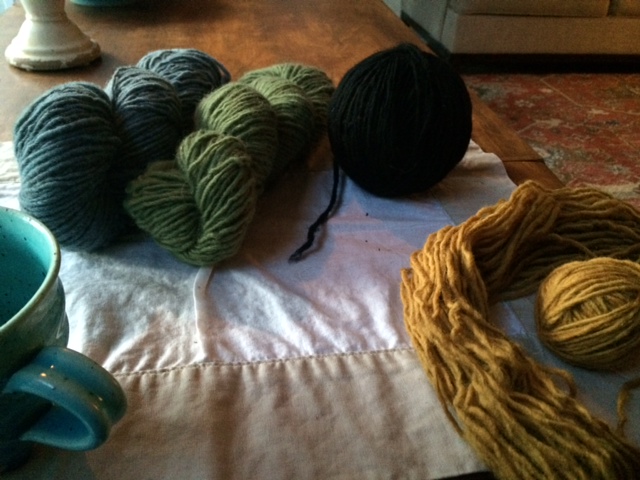Artists tend to be unconventional people.
Certainly, some of us are more peculiar than others.
It is Friday night and I’m sitting at home alone.
For a moment, I step beyond myself and consider the scene, as if I were outside looking through the window.
The living room with its large, wool tufted rug is softly lit by a single bronze table lamp with an old-fashioned, Tiffany-style glass shade.
In front of the unlit fireplace and brick hearth, an upright Navajo-style loom stands with a thick sheepskin pelt placed on the floor before it.
On the narrow wooden table by the front windows, a pale yellow beeswax taper flickers softly, reflected in the glass against the dark night. That same table is piled with several twisted, figure-8 looking skeins of woolen yarn in natural hues—cream, butter, blue sky, harvest gold, coal black.
Some have already been rolled into softball-sized spheres—the stuff cats’ fantasies are made of. A few feet away, in the old upholstered chair beside the table with its bright candle and yarns, a man with greying but thick, unruly hair sits silently.
A cup of tea within reach, he gradually unloops the skein draped over his knee and winds its freed yarn into a ball that, when finished, he will place beside the others he has completed.
It could be a scene from the early 1900s. Earlier, even.
This quiet, candlelit cottage could be anywhere: on the wild west coast of Ireland, in the Peruvian Andes or the high desert of New Mexico. Wherever its actual location, it seems a long way even from the neighbors along the street, those brightly lit houses with the ghostly blue glare of television illuminating their windows.
Somewhere in space and time, here I am, rolling yarn.
Unraveling a skein and winding it into a ball is a gently repetitive process, one that easily becomes a meditation. Hands travel repeatedly in a circular motion, slowly building the woolly sphere with each pass round its circumference.
Most folks would probably be doing this while parked in front of the television, distracted and entranced. I don’t own a TV, and I am utterly content in my quiet, unhurried ritual.
Suddenly I chuckle out loud, causing my two Whippets sleeping on the sofa to look up.
“This is so damn manly, sitting at home alone on a Friday night, winding balls of yarn and drinking tea. Just call me Grandma.”
The cultivated quietude of my life suits me, and while it appeals briefly to the harried and oh-so-busy, after a day or two, most people would run screaming back to their noisy distractions.
As the soulful poet Rainer Maria Rilke wrote in “Letters to a Young Poet,”
“What is needed is, in the end, simply this: solitude, great inner solitude. Going into yourself and meeting no one for hours on end—that is what you must be able to attain.”
Amen, Rilke.
I’ve only recently begun weaving.
As a writer who spends long hours stringing words together, rearranging and polishing them like colored beads on a necklace, I often yearn for something less mental. Something tactile and sensory. Tangible. Something I can step back from and actually see. Something more “real” than a paragraph.
I have long adored handmade ceramics and textiles, and one day the rustic simplicity of a Navajo loom reached out to strum something in my old-fashioned soul. In the craft/hobby/art field, weavers are predominantly women, so I’m upholding the minority.
I’ve long ago tossed aside those stale notions of what constitutes “masculine.” I’m simply interested in whatever expresses and nourishes my soul in a creative, authentic way.
In our modern world, most of us do but few of us make. Our paper economy has turned us into consumers rather than producers, and the once-valued practice of having a craft or being an artisan has largely been abandoned. It seems to be mainly just the artists who have hung onto the idea of craft, keenly aware of its importance to the soul—which is inherently creative—and the deep sense of value and identity it offers.
Certainly, as an author, my craft is writing rather than weaving. Yet working with the Navajo loom is not only a timeless metaphor for life, it offers a sensory meditation, a welcome respite from pushing words around on paper (or the computer screen). In yoga-speak, it’s a counterpose, flexing me into a different expression while stretching an opposing, counterbalancing group of muscles.
Weaving on a hand loom is slow, patient work, requiring complete presence. I love it.
“Weave in beauty,” say the Navajo.
There is also something in weaving that I savor as a communion with place. The yarn I use comes from a sheep ranch near Taos, New Mexico that raises the heirloom Navajo-churro sheep whose wool is traditionally used in this sort of textile weaving. It’s purchased from a small shop nearby, where they know the rancher and hand-dye the yarn themselves.
Patiently laying in the weft threads of natural colors and beating them down with a polished, wooden Navajo weaving fork held continuously in my hand, somehow connects me not only to craft, but to earth itself.
I know where this yarn came from. I have twice lived in northern New Mexico, and that wild, arid landscape of fragrant sagebrush beneath a wide turquoise sky still sings in my bones like an ancient chant.
More than craft, more than a respite from writing—and more than a social Friday night—this yarn weaves me into the larger story in which we are all connected.
May we all live and weave in beauty.
Relephant:
Untangling my Mind: a Knitting Meditation.
Author: L.R. Heartsong
Editor: Khara-Jade Warren/Editor: Emily Bartran
Image: Courtesy of the author












Read 1 comment and reply